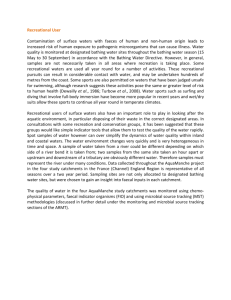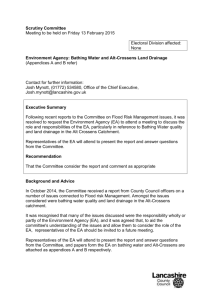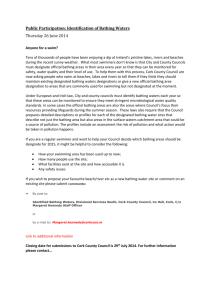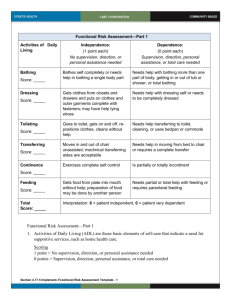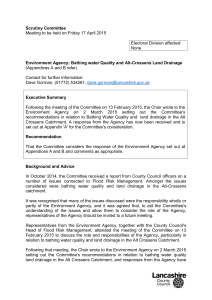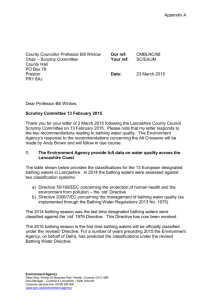16.- Bathing Water Quality Key message
advertisement
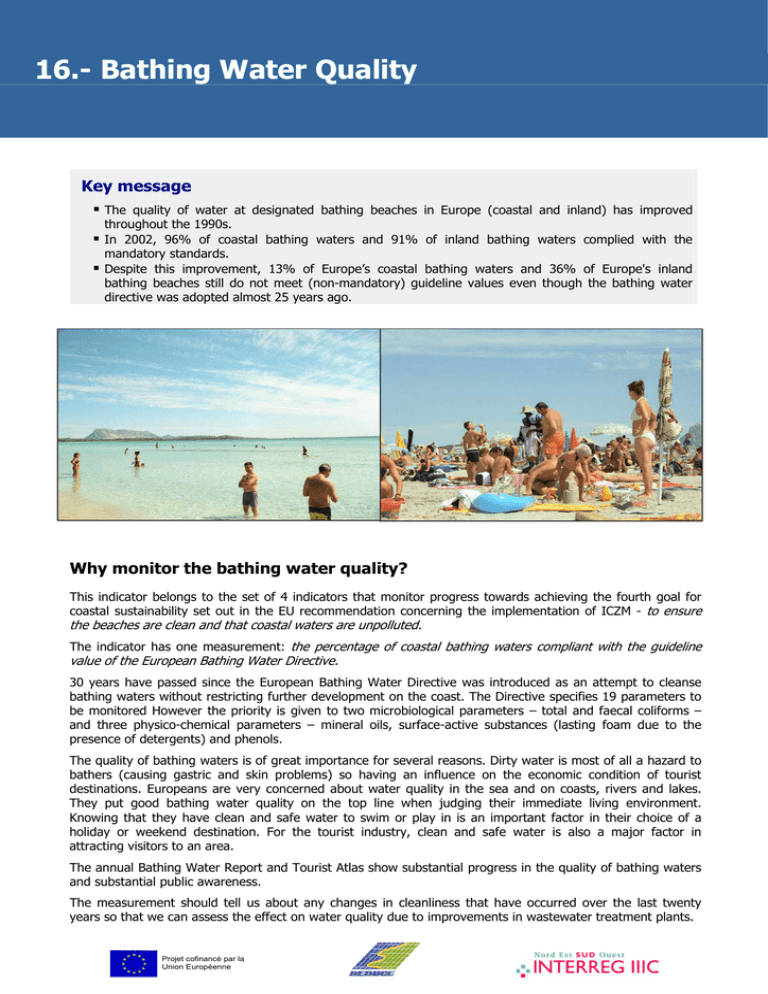
16.- Bathing Water Quality Key message The quality of water at designated bathing beaches in Europe (coastal and inland) has improved throughout the 1990s. In 2002, 96% of coastal bathing waters and 91% of inland bathing waters complied with the mandatory standards. Despite this improvement, 13% of Europe’s coastal bathing waters and 36% of Europe's inland bathing beaches still do not meet (non-mandatory) guideline values even though the bathing water directive was adopted almost 25 years ago. Why monitor the bathing water quality? This indicator belongs to the set of 4 indicators that monitor progress towards achieving the fourth goal for coastal sustainability set out in the EU recommendation concerning the implementation of ICZM - to ensure the beaches are clean and that coastal waters are unpolluted. The indicator has one measurement: the percentage of coastal bathing waters compliant with the guideline value of the European Bathing Water Directive. 30 years have passed since the European Bathing Water Directive was introduced as an attempt to cleanse bathing waters without restricting further development on the coast. The Directive specifies 19 parameters to be monitored However the priority is given to two microbiological parameters – total and faecal coliforms – and three physico-chemical parameters – mineral oils, surface-active substances (lasting foam due to the presence of detergents) and phenols. The quality of bathing waters is of great importance for several reasons. Dirty water is most of all a hazard to bathers (causing gastric and skin problems) so having an influence on the economic condition of tourist destinations. Europeans are very concerned about water quality in the sea and on coasts, rivers and lakes. They put good bathing water quality on the top line when judging their immediate living environment. Knowing that they have clean and safe water to swim or play in is an important factor in their choice of a holiday or weekend destination. For the tourist industry, clean and safe water is also a major factor in attracting visitors to an area. The annual Bathing Water Report and Tourist Atlas show substantial progress in the quality of bathing waters and substantial public awareness. The measurement should tell us about any changes in cleanliness that have occurred over the last twenty years so that we can assess the effect on water quality due to improvements in wastewater treatment plants. Projet cofinancé par la Union Européenne Results and assessment What does the indicator show from European to local level? The results gathered at EU level show that the quality of water at the designated bathing beaches in Europe (coastal and inland) has improved throughout the 1990s in terms of compliance with the mandatory standards laid down in the Bathing Waters Directive. In 2002, 96% of coastal bathing waters and 91% of inland bathing waters complied with the mandatory standards. Despite that improvement, 13% of Europe’s coastal bathing waters and 36% of Europe's inland bathing beaches still do not meet (non-mandatory) guideline values even though the bathing water directive was adopted almost 30 years ago. The original aim of the 1975 Directive was for member states to meet the prescribed standards by the end of 1985. This was not achieved even when member states have invested significant amounts of money in the improvement of sewage treatment processes. In some cases those works did not result in full compliance with bathing water quality standards due to diffuse pollution which still remains a source of microbiological and other contamination (e.g. Morecambe Bay, UK; Jones et al 1999). It is worth underlining that the implementation of the Urban Waste Water Treatment Directive has also contributed significantly to the improvement of surface water quality, including bathing waters. It must be noted that the data obtained at EU level only concerns the “old” EU countries. When looking at the Catalonian coast, there has not been any point of control observed below the mandatory level since 2003. These very good results are even a little bit better than the Spanish average since 1996. This indicator clearly reflects the efforts made in sewage infrastructure improvement. Quality of Bathing Waters, North Sea region Quality of Bathing Waters at the Catalan coast 100% 100% 80% 80% 60% % 60% 40% 40% 20% 20% 0% 0% 1990 1991 1992 1993 1994 1995 1996 1997 1998 1999 2000 2001 2002 2003 2004 1988 1989 1990 1991 1992 1993 1994 1995 1996 1997 1998 1999 2000 2001 2002 2003 guide mandatory non compliant In the southern part of the North Sea region, the water quality at designated bathing areas has improved steadily throughout the 1990s. In 2004, 98% of the sampled coastal bathing waters within the region complied with the mandatory standards, while 58% of the sites complied with the guideline value, which is 20 times stricter. Results and assessment In France, only 2% of the sampling points were not compliant with the European Directive in 2003 Quality of Bathing Waters at the French coast 100% Quality of Bathing Waters, Malta 90% 120 80% 100 Percentage % 70% 60% 50% 40% 30% 80 60 40 20 20% 0 1999 10% 1993 1994 1995 1996 guide 1997 1998 mandatory 1999 2000 2001 2002 2001 2002 2003 2004 Total Coliforms (Mandatory) Percentage of compliant sampling points Total Coliforms (Guide) Percentage of compliant sampling points Faecal Streptococci (Guide) Percentage of compliant sampling points 0% 1992 2000 2003 non compliant In Latvia and Poland, compliance with the BWD requirements is not complete, although the situation is improving. In Latvia, starting from 2003, more than 80% of bathing areas are compliant with guideline and mandatory values. All of the bathing areas not compliant with BDW are located in the eastern part of the Gulf of Riga and this is most probably a consequence of river pollutants being transported by the coastal currents. In the Pomeranian Voivodship (Poland), the quality of the costal bathing waters has systematically improved over the last four years. Nevertheless, the number of coastal bathing areas satisfying the European guideline standard is smaller than in most European coastal countries - in 2004, the percentage of such bathing areas reached 30.49% and the two closed bathing waters constitute only 2.44% of all coastal bathing waters. The quality of these two closed bathing waters should be improved by extending the collector of the existing water treatment plant further seawards. 17°00' 17°30' 54°40' W³adys³awowo# #m 19°30' Bathing waters fulfilling guide standard ## # # £eba Choczewo # # #Krokowa # # 54°20' 54°20' # 19°00' # # # # 54°40' 54°00' 54°00' # 18°30' ## #### ## ## 53°40' Bathing waters fulfilling mandatory standard # #### Bathing waters worse than mandatory standard # # ## # Jastarnia Insufficiently monitored bathing waters # Puck # # Wicko Border of coastal administrative units ### # # # # # # #Smo³dzino # # # G³ówczyce Puck Hel # # # Ustka ## Kosakowo# # ### # Lêbork m. # Gdynia# # # S³upsk# m. # # # # # # # #### # ## # # # # Gdañsk # # Krynica Morska # # ## ### # # # Sztutowo ## # ¯ukowo # # m. ## m. ## # # ## Kartuzy Stegna # # # # # # # # # # # # ## # # ## ### # # ## # Bytów m. # # # # # #### m. #Koœcierzyna # # # m. # # Tczew # # ## # Skarszewy#m.# # # # # ## ## # # # # # ## ## # Starogard Gdañski m. # # ### # Pelplin # Sztum # m. # # # ### # Brusy m. ## # # # # # # # # # # # # # # ## # # # Czersk m. # # # # # # # ## #### ## ## Czarne m. #Chojnice m. # ## # # # # 53°40' 18°00' # # # 17°00' 17°30' 18°00' 18°30' 19°00' 19°30' The 1976 Bathing Water Directive mirrors the state of technical knowledge and experience of the early 1970s. Since that time, epidemiological knowledge has progressed and managerial methods have improved, so leading to the New Directive 2006/7/EC. The new Directive lays down provisions for more sophisticated monitoring and classification of bathing water. It also provides for extensive public information and participation in line with the Århus Convention as well as for comprehensive and modern management measures. Policy and management for a sustainable coast What are the implications for planning and managing the coastal zone? We can say that the indicator message for policymakers is clear: regulating the quality of bathing water through the Bathing Water Directive has led directly to an improvement in the state of the environment and reduced the impact of faecal pollution n human health and marine life. While this is true, it is not the whole story. The drive for cleaner bathing waters has been abetted by the Urban Waste Water Directive which has led to significant investment in upgrading and renewal of urban coastal sewage systems. Both Directives have been supported by the public, environmental NGOs and the tourist industry, The Europa bathing water website receives more that 2 million hits each year as holidaymakers check out possible destinations. Substantial public approval of the goal to eliminate faecal pollution, coupled with effective regulations on pulling in the same direction, has been a potent force for driving up the quality of bathing water. More of the same should be the objective of good management. RELATED POLICIES NAD INDICATORS 1. Demand for property on the coast 2. Area of built up land 5. Pressure for coastal and marine recreation 6. Land taken by intensive agriculture 19. Amount of oil pollution Bathing Water Quality 14. Intensity of tourism 18. Concentration of nutrients 15. Sustainable tourism 17. Amount of coastal litter Policy and management for a sustainable coast Further work needed In general, the data on bathing water quality is easily available both at European level (free access to the DG-Env database) and at national/regional level. Some problems could be found regarding the new EU countries where data is available only from 2002 and the methodology used by the national agencies sometimes differs from the one required by the BWD. Even so, several reflections on data availability and indicator usefulness were provided by the project partners. Here are the most important points: - To see the spatial dimension of the indicator it would be worthwhile also showing the results in a variant of the map. - It has to be remembered that the trends in the quality of the coastal waters may also reflect deep inland problems. - Given the location of the sampling points and the fact that the samples are collected only in the bathing season, the measurement only covers that particular time frame and is not necessarily indicative of the annual situation. - Currently, the sampling parameters relate to sewage. To have a clear picture of the quality of bathing waters, it is likely that other parameters would have to be included. Additional parameters within the indicator measurement may be included to reflect changes in the Bathing Water Quality Directive. - in Poland, the national regulations on quality of bathing waters should be changed to conform with European standards to allow easy and explicit comparison of the quality of Polish and European bathing waters. At the moment, the data transferred to the DG-Env database does not reflect the real situation as most of the bathing areas - according to the requirements of the BWD - are not sufficiently sampled and as such are listed on the bathing water website. Further information Data sources European Topic Centre Terrestrial Environment (ETC-TE) DG-Env Department of Environment ND Housing of Catalan Government Agència Catalana de l'Aigua (ACA) Institut français de l'Environnement The Ministry of Heath University of Latvia The Society Health Agency, Riga, 2006. Malta Environment and Planning Authority (MEPA) The Environmental Health Unit of the Department of Public Heath Maritime Institute Gdańsk The Voivodship Sanitary and Epidemiological Station (VSES) Province of West Flanders European Environmental Agency Reliability of the indicator The data on bathing water quality are very reliable and are based on common methodology across Europe. This allows easy comparison between countries. At European level, the data are stored in the DG-Env database, which is updated annually and is freely accessible. One main constraint, perhaps common elsewhere, is related to the selection of the sampling points, which are all located close to the shoreline rather than spatially distributed within bathing areas The yearly changes in the number of sampling stations should also be considered as having a potentially significant influence on the annual compliance rate. In Poland, while counting the indicator some difference appeared between the water quality standards of the BWD and the national standards defined by the Ordnance of the Ministry of Health. The most significant difference is that the Polish standard for Escherichia coli faecal coli bacteria allows a two times lower number of these bacteria for mandatory quality level than the European standard (European standard – not more than 2000, Polish standard – not more than 1000). The Polish standards also do not include the determination of enteroviruses and water transparency is determined by means of a standard plate instead of a Secchi disc. References None Projet cofinancé par la Union Européenne
